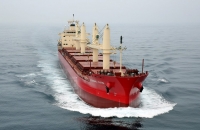
ALEX BINKLEY, CANADIAN SAILINGS
Great Lakes ship operators are divided on their prospects for 2019 with Algoma Central, Canada Steamship Lines and Fednav cautiously optimistic that they will be at least as busy as in 2018. The 6.8 per cent increase in cargo handled by The St. Lawrence Seaway Management Corporation in 2018 over 2017 adds to their confidence.
Canfornav and Spliethoff have a gloomier outlook about the volumes that will flow in and out of the Lakes this year because of uncertainty about the North American economy, iron ore prices, global grain and oilseed demand and American steel and aluminum tariffs.
Peter Winkley, CFO of Algoma Central Corp., said, “We don’t see any big reductions in business. Steel production is still solid. We don’t see a lot of change in the other exports. It should be a fairly busy year.” If anything, Algoma is looking at how to meet the demand for shipping when it’s down one ship compared to original expectations for its fleet in 2019, he said. The Croatian shipyard that built one new Equinox class freighter failed to keep up production that would have delivered another new vessel in time for the 2019 season. Algoma has received a refund from 3.Maj Shipyard of Croatia of the $115 million it advanced for new vessels. As a result, Algoma has arranged an extension to the expiry dates on three existing option contracts with Yangzijiang (YZJ) Shipyard in China until later this year, Winkley said. It has yet to decide whether Equinox Class self-unloaders or gearless bulkers would be more useful.
Algoma contracted for the building of two Equinox self-unloaders by YZJ in 2015 and subsequently enlisted the support of the shipyard to complete two of the partially built Nantong Mingde hulls, which Algoma acquired from that bankrupt shipyard. The fourth of those is expected to be in service for the 2019 navigation season.
Julie Lambert, Senior Director, Commercial for Canada Steamship Lines, said, “A strong season is forecast for 2019 across all commodities we transport on the Great Lakes. During a busy 2018 navigation season, Canada Steamship Lines fully utilized all operating ships.” Lambert said that CSL had to keep one freighter tied up for most of the 2018 shipping season because of crew shortages.
Fednav’s FALLine operation is entering its 60th year of serving the Great Lakes. “It is too early to estimate what volumes of steel our inbound shippers will deliver,” said Dennis Pfeffer, who is Liner Manger, and Ami Zack, Chartering Manager. “All in all, we currently have no reason to believe 2019 will be any different from 2018 in terms of imported steel shipments. As regards export tonnage, again it’s early to say what 2019 will bring in terms of bulk exports. It is safe to say, however, that we have some of the most professional companies in the world marketing our U.S. and Canadian grains, that demand for domestic canola looks to be much better than we had seen in 2018, and that there is a lot of high quality durum in North America that was not moved in 2018,” they said.
For Fednav, 2018 was quite a year with respect to steel imports, considering tariffs imposed by the United States, Pfeffer and Zack said. The introduction of the 25 per cent duty on steel imports brought about great uncertainty about import tonnage volumes from Europe for FALLine. “Ultimately, inbound tonnage led by flat products for the automotive industry, followed by structural steels, wire rods, and plates remained steady as prices for American steel increased nearly offsetting the tariffs imposed,” they said. “In addition, construction projects within Canada remained robust throughout the year which meant good volumes of beams.” The hefty bulk exports via the Seaway provided plenty of cargo for Fednav.
On the other hand, Errol Francis, Vice-President of Operations for Canfornav, said the signs so far this year are not encouraging. The line “had a reasonably good year in 2018 but 2019 has not started very well, with a depressed freight market, and it’s difficult to predict the future, as clearly the trade wars and tariffs seem to be taking a toll.”
Meanwhile Bart Peters, head of the Atlantic Department of Spliethoff Shipping, said 2018 was a tough year for the company’s Cleveland Europe Express, and 2019 isn’t likely going to any better as the CEE enters its sixth year when navigation commences.
“Freight rates are under pressure, and costs continue to increase,” he said. “The most urgent problem now, which damages the Great Lakes trade, is the pilotage issue.” One positive for his company is that CEE will have Logistec as its terminal operator in Cleveland, he said.
Peters said the increasing pilotage costs mean more freight moves by trucks and trains than ships, meaning consumers and manufacturers in the U.S. and Canada “pay too much for the transportation of whatever they buy or sell, and they will not be able to compete in export markets.”
Source: canadiansailings.ca/shipping-lines-optimistic-about-2019-prospects-on-the-great-lakes





